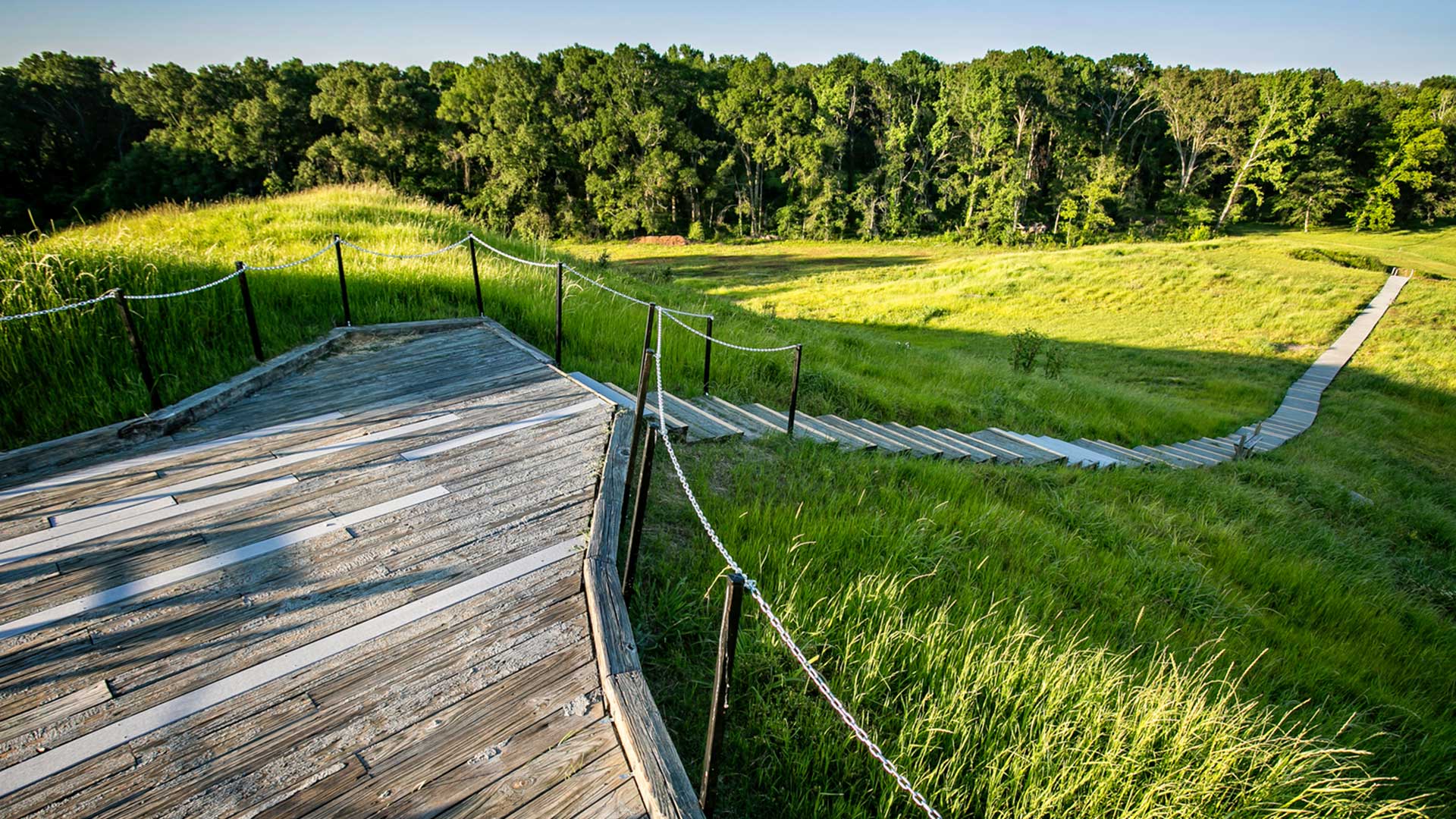The nearly 100 Interpretive Centers along the Great River Road tell the story of the people, places, and events that have shaped life and culture along the Mississippi River. Whether you’re traveling the whole Great River Road or just visiting one state, you’ll find lots of great places to explore—here’s a look at one must-visit Interpretive Center in each state along the route.
Jacob V. Brower Visitor Center at Itasca State Park, Minnesota
See the start of the Mississippi River at Itasca State Park in north-central Minnesota. Itasca State Park is Minnesota’s oldest state park, covering more than 25,000 acres and containing more than 100 lakes. At Lake Itasca, the Mississippi River starts its 2,500-mile trek to the Gulf of Mexico (it’s only about 25 feet wide here, and in warmer months, visitors can wade in the headwaters or use steppingstones to walk across the river). The Jacob V. Brower Visitor Center is open year-round and features information about the park and the area, educational exhibits, interactive play areas, a large fireplace, a gift shop, restrooms, and more.
See more Interpretive Centers in Minnesota.
Freedom Park Great River Road Visitor Center, Wisconsin
Located at the confluence of the Mississippi and St. Croix rivers in northwestern Wisconsin, the Great River Road Visitor Center at Freedom Park is an Interpretive Center and city park that offers spectacular views, educational programming, community events, and wonderful birding and wildlife watching opportunities.
See more Interpretive Centers in Wisconsin.
Villa Kathrine, Illinois
This unique building, which houses the city of Quincy’s Tourist Information Center, sits amidst a 4-acre park overlooking the Mississippi River in west-central Illinois. The Villa Kathrine was built in 1900 for wealthy local resident W. George Metz and incorporates Mediterranean and Moroccan designs into its unique architecture—many of the elements came from sketches of Islamic architecture that Metz observed on his world travels.
See more Interpretive Centers in Illinois.
Effigy Mounds National Monument, Iowa
About 2,700 to 3,500 years ago, nearly two dozen American Indian tribes constructed countless effigy mounds throughout Wisconsin, Minnesota, Iowa, and Illinois. Today, important remnants of that culture can be found at Iowa’s Effigy Mounds National Monument, which is home to more than 200 effigy mounds on one of the most scenic sections of the Mississippi River. The park’s visitor center features exhibits and artifacts outlining the area’s natural and cultural history, and visitors can also explore several hiking trails that pass by the effigy mounds and other notable sites.
See more Interpretive Centers in Iowa.
Gateway Arch National Park, Missouri
Visit one of the iconic sights along the Mississippi River and the Great River Road at Gateway Arch National Park in St. Louis. From the top of the arch, visitors can enjoy a breathtaking view of St. Louis and the surrounding area. The Museum of Westward Expansion tells the story of America’s growth as a nation during the 1800s and features several unique artifacts, including items from the Lewis and Clark expedition.
See more Interpretive Centers in Missouri.
Columbus-Belmont State Park, Kentucky
Columbus-Belmont State Park offers outstanding views of the Mississippi River in far western Kentucky, but it was also the site of a notable 1861 Civil War battle—the first active engagement in the war by Ulysses S. Grant. Visitors to the park can explore a Civil War museum that includes artillery shells and other items, and a giant six-ton anchor (which was part of a plan to blockade the river) is also on display at the site.
See more Interpretive Centers in Kentucky.
Chucalissa and the C.H. Nash Museum, Tennessee
Chucalissa, located in southwest Memphis, allows visitors to explore a culture that flourished before the first Europeans landed in America. This archaeological site was occupied, abandoned, and reoccupied several times between 1000 and 1500 A.D. and was part of a large political system called the Mississippian culture. The C.H. Nash Museum curates an extensive collection of artifacts recovered from excavations of the site.
See more Interpretive Centers in Tennessee.
Lakeport Plantation, Arkansas
Lakeport Plantation in Lake Village dates to the 1830s and produced cotton for nearly a century. Today, it’s an educational site run by Arkansas State University that provides a full picture of plantation life in the South, including exhibits on slavery, sharecropping, the Civil War, and Reconstruction.
See more Interpretive Centers in Arkansas.
Delta Blues Museum, Mississippi
The blues was born in Mississippi, and music lovers of all kinds will find an educational and fascinating experience at the Delta Blues Museum in Clarksdale (which is also home to the famous “Crossroads” where Robert Johnson reportedly sold his soul for his unearthly talent). The museum contains lots of interesting items, including the sharecropper home of Muddy Waters and instruments played by greats like John Lee Hooker, B.B. King, and Big Mama Thornton.
See more Interpretive Centers in Mississippi.
Poverty Point World Heritage Site, Louisiana
One of only 24 UNESCO World Heritage sites located in the United States, Poverty Point World Heritage Site (near the village of Pioneer in far northeastern Louisiana) contains the remnants of a complex array of earthen works that predate the Mayan pyramids. The purpose of the mounds and ridges remains a mystery, although many believe they were the site of homes. The site dates to as early as 1700 B.C. and encompasses more than 400 acres. Tram tours are offered daily.
See more Interpretive Centers in Louisiana.
(Photo: Louisiana Office of Tourism)








